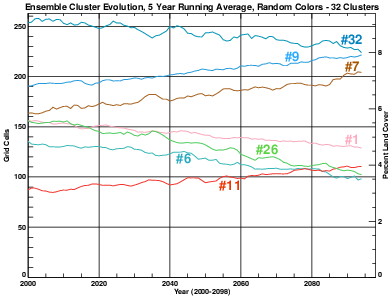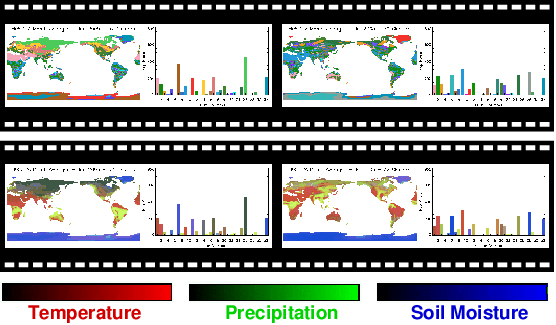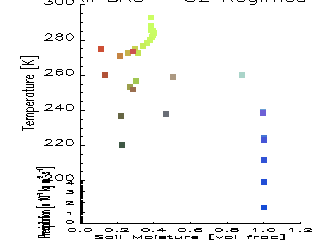Using Clustered Climate Regimes to Analyze and Compare Predictions from Fully Coupled General Circulation Models
 |
Five year running average of cluster frequency for regimes exhibiting significant global land area changes in the ensemble mean where the clusters are defined as follows:
| 32 |
Antarctic/Greenland Fall/Spring #1 |
| 9 |
Desert Summer (Hottest and Driest) |
| 7 |
Antarctic/Greenland Fall/Spring #2 |
| 1 |
Desert Winter |
| 26 |
Siberian/Canadian Winter |
| 6 |
Antarctic Winter #1 (Coldest and Driest) |
| 11 |
Antarctic/Greenland Summer |
|
- Multivariate Spatio-Temporal Clustering
(MSTC) was applied to the monthly time series output from five
99-year Business-As-Usual (BAU) transient simulations of the Parallel Climate Model (PCM) from 2000-2098
- MSTC establishes an exhaustive set of recurring climate regimes which form a "skeleton"
through the "observations" (model output) throughout the occupied portion
of the climate phase space formed by the
characteristics being considered. Temperature, precipitation, and soil
moisture were included in this analysis.
- Strong predicted interannual trends
were revealed in this analysis, including an increase in global
desertification; a decrease in the cold, dry high latitude conditions
typical of North American and Asian winters; and significant warming in
Antarctica and western Greenland.
- MSTC is a powerful tool for model developers and environmental
decision-makers who wish to understand long,
complex time series predictions of models.
- MSTC facilitates direct comparison of ensemble members,
ensemble and temporal averages, as well as observational data since
the derived climate regimes provide a basis for
comparison.
 |
| Random (top) and similarity colored (bottom) animations of the B05.12 ensemble member in terms of the common climate regimes shown at right. Click on the desired image above to view the animation. |
|
 |
| Common climate regimes or states statistically defined in terms of three variables--temperature, precipitation, and soil moisture--for all five BAU transient simulations taken together. |
|
References:
Hoffman,
Forrest M., William W. Hargrove, David J. Erickson,
and Robert J. Oglesby. August 3, 2005. "Using
Clustered Climate Regimes to Analyze and Compare Predictions
from Fully Coupled General Circulation Models." Earth
Interactions, 9(10): 1-27, doi:10.1175/EI110.1.
[ PDF ]
Graphics and animations are available at http://www.climatemodeling.org/pcm/.
Research partially sponsored by the U.S. Department
of Energy, Office of Science, Biological and Environmental Research
Programs. This research used resources of the National Center for
Computational Sciences at Oak Ridge National Laboratory which is supported
by the Office of Science of the U.S. Department of Energy under Contract
No. DE-AC05-00OR22725. Support was also provided by a research and
development grant from the Science Directorate of NASA/MSFC.
